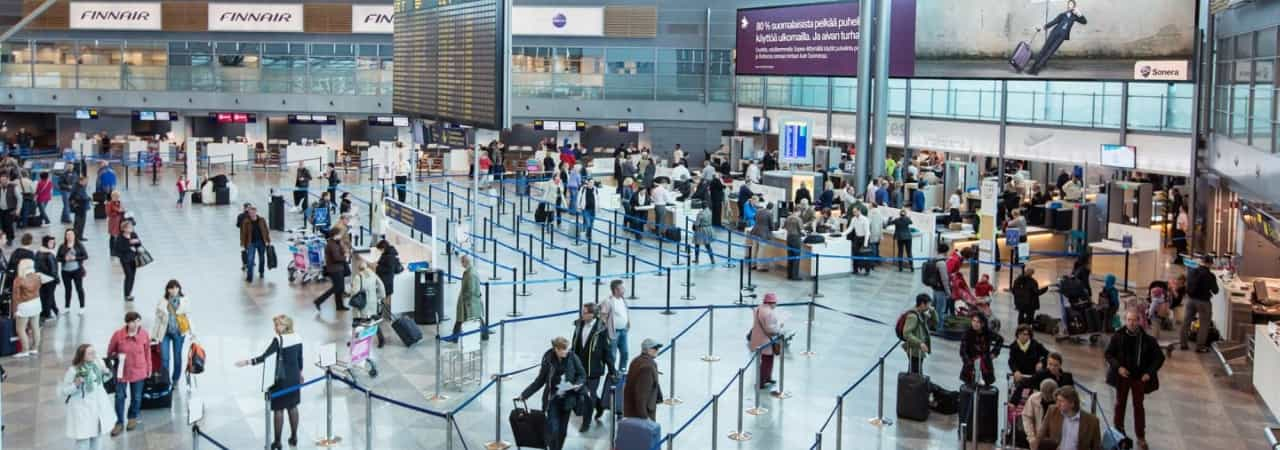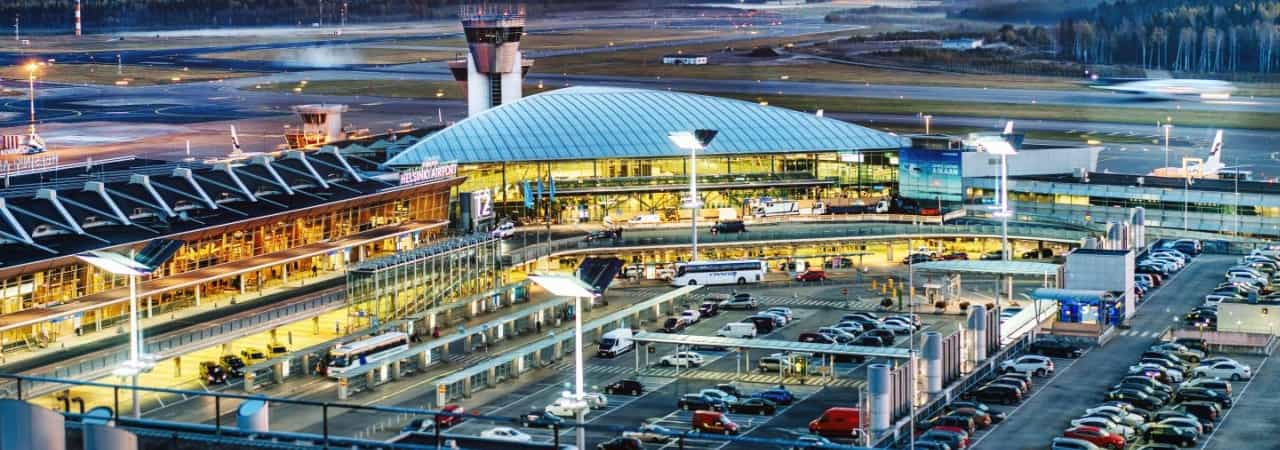Transparency via RFID increases passenger satisfaction
Having sat in a plane for multiple hours after three weeks of holiday, having waited ages to finally take one's own suitcase from the baggage carousel and… there is no baggage trolley! A nuisance that happens numerous times at airports all around the world. However, there are usually enough luggage trolleys at the airports – just not where they are needed. The challenge is to have a sufficient amount of baggage trolleys ready at the right time and right spot, and this challenge is what Finavia – operator of currently 21 airports in Finland – accepted at the Helsinki airport.
Today, an RFID-based application including all-surface-RFID tags from Confidex is the foundation for a high degree of customer satisfaction at the Helsinki-Vantaa Airport. RFID & Wireless IoT Global reports on what steps needed to be taken before the eventual launch of the baggage trolley tracking.
Around 19 million passengers per year
More than 50,000 passengers either take off from or land at Helsinki airport per day. 85 percent of these passengers travel from or to international destinations. More than 30 percent of all passengers use the airport for transfer. Even though the share of passengers travelling only with hand luggage has been increasing for a few years due to extra charges, passengers still travel with several thousand sometimes heavy suitcases and bags. In order to transport them, like at hundreds of other airports worldwide, baggage trolleys are being used.
This would not be anything special. However, no or not enough baggage trolleys being available to the passengers, often in combination with possible travel stress, causes resentment. Yet, how can the airport management ensure that after a landing, for example, there are enough baggage trolleys available at the baggage carousels? The fact that the airport management aims to increase the passenger numbers significantly in the following years shows the importance of answering this question. An increase in passenger numbers effects the best possible organisation of baggage trolleys directly.
Prepared for 30 million passengers
The Helsinki airport is currently subject to an extensive development program. The entire infrastructure is being prepared to provide around 30 million passengers annually the best possible travel experience at take-off and landing. About one billion Euros has been invested to reach this goal. The terminal area is to be enlarged by 45 percent to 103,000 square meters by the beginning of the next decade. The capacity of the baggage handling system will by increased by 50 percent.
Eight new gates for wide body aircraft will be installed while the number of gates for short and medium haul aircraft will grow by 15 percent. In addition, pass control capacity will grow by 50 percent, a total of 4,800 new car parking spots will be created, the apron area of 450,000 square meters will be renovated, and new multimodal travel centre will be built. With the infrastructure program, up to 5,000 permanent jobs are to be created.
Transparency via RFID increases passenger satisfaction
Another challenge to ensure customer satisfaction is that the Helsinki-Vantaa Airport is facing growing competition from other (northern) European Airports regarding transit traffic due to a significant rise in Asian passengers. So, keeping transit traffic and passenger services as smooth as possible compared to competitors is more and more important to the airport operator Finavia. To optimise customer service, Finavia was searching for a solution to drastically minimise the effort for the time-consuming, manual handling – from searching to finding – of baggage trolleys between parking cars or at baggage carousels.
Baggage trolleys are just left anywhere in the car parking sites. The opposite is the case at the boarding: The trolleys are concentrated there, because the individual gates are only accessible via central entries. In parallel to this main goal, Finavia also wanted to better understand the passengers’ behaviour in the airport area in order to predictively meet their needs.
To meet targets mentioned and to answer the initial question – How can it be ensured that all around the airport, the number of baggage trolleys needed is available? – Finavia today uses an UHF RFID solution.
Solution: higher availability of baggage trolleys thanks to RFID tracking
The Finnish system integrator Top Tunniste developed a baggage trolley tracking system that is tailor-made to meet the airport’s requirements. Today , every single trolley is equipped with an individual RFID tag. Top Tunniste’s technicians chose the customised Confidex Carrier tough II tag due to the optimal ratio of readability, ruggedness, and slim construction. The readers were installed in the lobbies of the arrival and departure areas. When a passenger pushes a tagged baggage trolley past one of these reading points, the trolley ID is captured. This is to make sure that every baggage trolley is tracked individually.
Data analysis in the cloud
As soon as a luggage trolley is captured in the reading field of one of the installed RFID readers, data is sent to a cloud-based application. In the cloud, all the information on every individual baggage trolley is collected, thus allowing detailed monitoring, control, and reporting of the movements and locations.
Based on the RFID solution, Finavia is today able to improve the usage of existing baggage trolleys and to ensure an optimal availability at parking sites and in terminals within the rush hours. “The existing knowledge of our employees is digitised in a format that is easy to understand and reportable with the RFID system. The optimised level of knowledge can significantly improve the use of time, planning, and operation at the airport,” says Niko Ropa, Operations Supervisor at Finavia.
User behaviour optimises the process
The continuous tracking of the baggage trolleys in the different areas of the airport makes acquiring data on user behaviour possible. When combining this data with latest flight information, such as delays, the trolley allocation can be planned predictively. Based on flight profiles, e.g. whether there is a holiday flight or a business flight approaching, the number of passengers arriving is predictable. With a deeper knowledge concerning usage rates and the number of baggage trolleys required, it is possible to allocate the trolleys according to the actual needs of the passengers and to plan the underlying processes better.
Trolley tracking as a marketing tool
On top of the organisational benefits, the RFID tracking system also creates added value regarding marketing options. Due to the precise information on the paths every individual trolley takes over a year, the exact distances and dwell times at locations such as parking sites or the departure areas help the selling of advertising spaces on the trolleys. Advertising companies can place their marketing messages in a more targeted way thanks to the tracking data.
Outlook: An automated maintenance management
The update of the location system provides the Finavia employees with the opportunity to establish additional functionalities from the solution. For example, handhelds can be used to reliably and quickly identify specific luggage trolleys. At the same time, the analysis of all captured data allows the drawing up of an individual maintenance and service plan. The entire lifecycle of a luggage trolley can thus be followed digitally. Moreover, in future, there will be the possibility to extend the rolled-out RFID solution to other areas – for example shopping carts in the shopping areas of the airport.
Conclusion: RFID has an effect
The RFID solution integrated by system integrator Top Tunniste provides realtime information on the number of baggage trolleys in the different airport areas, allowing an immediate reaction to shortages. This led to a significant improvement of trolley availability as transportation processes performed by Finavia employees are more efficient now.
Like the ASQ query (airport service quality) shows, the service rating regarding luggage trolleys improved compared to the time without RFID tracking. This has not been the case for years.
All information regarding any individual trolley is digitised in a measurable and verifiable way enabling monitoring and future development of operations. The working methods and processes were restructured based on the information generated by the system. The goal to design the trolley allocation in the transit area of the airport as smoothly as possible for the passenger was achieved. Through this, customer service of Finavia concerning the passengers in this field was improved. Top Tunniste individualised and implemented the RFID tracking system with regard to the requirements.
Finavia is content with the solution and the cooperation with Top Tunniste, according to Niko Ropa: “The best of the cooperation was the quick implementation and the customer orientation. Top Tunniste and the RFID solution help us to offer first-class services to our customers.”





